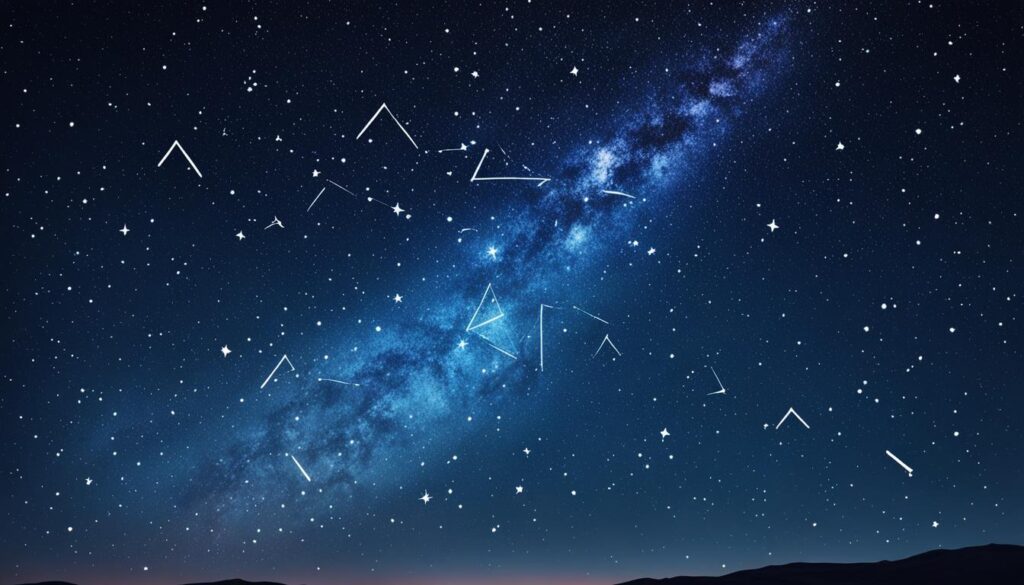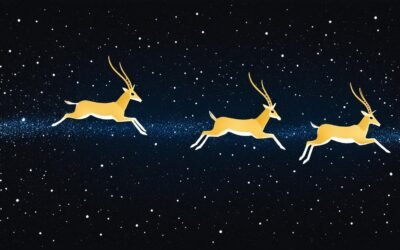As you gaze into the crisp, clear skies of the cooler months, you may become acquainted with a remarkable configuration of stars known as the winter triangle asterism. This triangular constellation in winter is composed of three prominent winter stars: Betelgeuse, Sirius, and Procyon. Not only does this stellar trio light up the night sky with their brilliance, but they also serve as celestial beacons, guiding you through the heavens. Identifying the winter triangle in the night sky is a rewarding experience for any star watcher, offering a gateway to the grand tapestry of the cosmos.
The allure of the evening canopy is heightened when you’re able to pinpoint such a distinctive asterism with ease. Standing out against the vast universe, this arrangement draws together mythology, science, and the spirit of exploration in one glance upward. Let this guide serve as your map to traversing the winter triangle and embracing the wonder it encapsulates.
Key Takeaways
- Understanding the winter triangle asterism enriches the stargazing experience.
- Remember, the triangular constellation in winter offers a signpost to more profound astral discoveries.
- Each point of this celestial triangle is a story written in the stars, telling of the past and the future through their singular luminescence.
- Armed with the knowledge of these prominent winter stars, you will be well-equipped for a foray into the night’s grandeur.
- Enjoy the thrill of identifying the winter triangle in the night sky, a testament to your growing astute observation skills.
Exploring the Stars of the Winter Triangle
As you gaze into the night sky during the frosty evenings, you might notice a pattern of stars drawing a near-perfect triangle. This celestial sight, known as the winter sky triangle, is made up of three prominent stars: Sirius, Betelgeuse, and Procyon. Each star’s brilliant light comes together to form the astronomical winter triangle, a guidepost for skywatchers and a treasure trove for those curious about our universe.
Sirius: The Sparkling Eye of Canis Major
Sirius, also heralded as the brightest star in our night sky, is a key vertex of the winter triangle asterism. Known as the sparkling eye of the Canis Major constellation, its proximity to Earth at only 8.60 light-years away, combined with its notable luminosity, makes Sirius abundantly clear on any clear winter’s night. This star shines with such brilliance that it has become a cornerstone in the lore of many cultures and a beacon for navigators past and present.
Betelgeuse: Orion’s Red Supergiant
The distinct reddish twinkle that stands out in the winter triangle belongs to Betelgeuse, Orion’s famed red supergiant. Proclaiming its presence in the Orion constellation, Betelgeuse captures the imagination with its vast size and fiery coloration. Stationed approximately 548 light-years away, its nearing supernova status adds a layer of excitement and anticipation for those who watch the stars. This red giant’s looming transformation secures its place among the night sky’s notable stars.
Procyon: The Little Dog Star in Canis Minor
Anchoring the last corner of the winter triangle is Procyon, a luminary member of the Canis Minor constellation. Its designation as the Little Dog Star speaks to its role accompanying Sirius, the larger Dog Star, across the celestial dome. Sitting 11.46 light-years from our planet, Procyon too is poised for a stellar evolution, ready to swell into a giant star. Together with Sirius and Betelgeuse, Procyon completes the astronomical winter triangle, serving as a glittering landmark in the vastness above us.
| Star Name | Constellation | Approximate Distance (light-years) | Status |
|---|---|---|---|
| Sirius (Alpha Canis Majoris) | Canis Major | 8.60 | Main Sequence Star |
| Betelgeuse (Alpha Orionis) | Orion | 548 | Red Supergiant (Supernova Candidate) |
| Procyon (Alpha Canis Minoris) | Canis Minor | 11.46 | Developing Giant Star |
The notable stars in the winter triangle offer more than just a striking visual array; they provide a window into stellar evolution and a celestial compass for understanding the vast canvas of the universe. Their steady glow throughout the winter months captures the imaginations of both the avid stargazer and the casual observer alike.
A Guide to Locating the Winter Triangle Asterism in the Night Sky
When seeking the winter triangle asterism visibility, the night presents a canvas for the celestial triangle of winter. By identifying the Winter Triangle, you connect with centuries of skywatchers who have found this pattern to be an invaluable reference in their celestial explorations. Whether you’re an amateur stargazer or an astronomy enthusiast, locating and identifying the Winter Triangle in the night sky is a rewarding experience that begins with a few straightforward steps.

As you venture out on clear winter nights, your first landmark is the distinctive three stars known as Orion’s Belt. Here is a concise guide to help you pinpoint the Winter Triangle:
- Orion’s Belt serves as your celestial starting point. Look for three aligned, bright stars at mid-northern latitudes.
- Track the line of Orion’s Belt southeastward to discover Sirius, the brilliant star that is part of the Canis Major constellation.
- From Sirius, move your gaze slightly upward and to the left to find Procyon of Canis Minor easily.
- Lastly, Betelgeuse gleams above the Belt’s easternmost star, completing the Winter Triangle.
For observers in the southern hemisphere, remember that the asterism appears inverted and is not visible during the months of June and July. Here’s a tabular breakdown of each star’s visual characteristics:
| Star | Constellation | Color | Magnitude | Position in Relation to Orion’s Belt |
|---|---|---|---|---|
| Sirius | Canis Major | Blue-White | -1.46 | Southeast of the Belt |
| Procyon | Canis Minor | Yellow-White | 0.38 | Above and left of Sirius |
| Betelgeuse | Orion | Red | 0.42 – 0.58 (variable) | Above the Belt’s eastern star |
These stars serve not only as seasonal beacons but also as waypoints leading you to other fascinating celestial features. Embrace the celestial dance of the stars and enjoy your journey through the night sky.
Uncovering the Bright Celestial Triangle of Winter
As you gaze into the clear night sky during the colder months, your eyes might be drawn to the winter triangle asterism, a brilliant guidepost amidst the stars. This geometric marvel, known in scientific circles as the astronomical winter triangle, is formed by connecting three of the brightest stars above: Sirius, Betelgeuse, and Procyon.
The asterism is not just striking for its shape but also for its visibility. When seeking the winter triangle asterism visibility, it’s essential to consider factors like light pollution and atmospheric conditions, which can significantly affect how well these stars can be observed. Fortunately, due to their brightness and prominence in the sky, the triangle’s corners cut through the night with impressive clarity.
Let’s break down the viewing experience:
- Sirius, the “Dog Star,” the brightest star in the night sky, acts as a beacon of winter. Its dazzling appearance is a testament to its proximity, a mere 8.6 light-years away.
- The red supergiant Betelgeuse introduces a hint of color to the triangle and is famed for its variable brightness, which can reshape the triangle’s perceived angles.
- Procyon, completing the asterism’s outline, blazes brightly just to Sirius’ upper left.
These stars serve as celestial lighthouses that not only brighten the winter nights but also unlock the doors to deeper cosmic exploration.
Enclosed within the confines of the Winter Triangle, the faint constellation Monoceros often goes unnoticed, yet it offers a backdrop to the asterism’s luminosity. The region is dense with nebulae and other deep-sky objects – a treasure trove for the avid astronomer or the curious stargazer.

With each star of the Winter Triangle holding its unique story, they collectively offer a narrative that spans across our galaxy. By anchoring your sights on this celestial triangle, you are not only observing a magnificent portion of the sky but also partaking in a storied tradition that reaches back to ancient times and stretches out into the expanse of space.
The Historical and Cultural Significance of the Winter Triangle’s Stars
The prominent winter stars of the Winter Triangle are not only fixtures in the night sky but also carry a wealth of lore and cultural significance that illuminate our past. The astronomical dance performed nightly by Sirius, Betelgeuse, and Procyon has been observed by ancient civilizations, shaping stories and guiding explorers across the celestial triangle of winter. Your appreciation for these heavenly bodies will deepen when you discover the tapestry of mythology and the role they’ve played in various cultures throughout history.
Sirius: The Dog Star’s Ancient Lore
Sirius, the “Dog Star,” has been a beacon within the winter sky triangle for millennia. Its association with Osiris, the Ancient Egyptian god of the afterlife, points to its prominence in winter constellations. Its bright and consistent appearance before dawn signaled the annual flooding of the Nile, a key event for Egyptian agriculture. The rise of the Dog Star embodied renewal and vitality, reflecting its standing in the night sky, and it continues to be a subject of fascination in modern astronomy.
Betelgeuse’s Mythological Connection to Orion the Hunter
The mighty Betelgeuse stands as the fervent heart within Orion, known in Arabic as the ‘Hand of Orion.’ The red supergiant forms an essential point of the Winter Triangle, representing the hunter’s shoulder and serving as a celestial marker for myriad cultures. Its fiery glow and eventual fate as a supernova encapsulate the tales of Orion’s bravado and tragic destiny. These stories persist, inspiring those who seek to uncover more about these distant suns. Betelgeuse’s place in the sky and in storytelling secures its role as a significant astronomical and mythological crossroad.
Procyon’s Role in Ancient and Modern Astronomy
Procyon completes the winter triangle asterism, preceding Sirius as they journey across the sky. Associated with foreshadowing the appearance of the Dog Star, this star has navigated sailors through safe and treacherous waters alike, acting as a crucial guide for ancient mariners. In contemporary times, Procyon’s closeness to Earth and status as a binary star system spark the interest of astronomers, who peel back the layers of our universe by studying its characteristics. Its consistent presence across the epochs continues to anchor the stellar map for both the curious onlooker and the seasoned observer.
FAQ
What is the Winter Triangle Asterism?
The Winter Triangle asterism, sometimes referred to as the Great Southern Triangle, is a prominent pattern in the night sky formed by three bright stars: Sirius, Betelgeuse, and Procyon. These stars are also the principal stars in their respective constellations: Canis Major, Orion, and Canis Minor.
Which stars make up the Winter Triangle?
The Winter Triangle comprises Sirius, which is the brightest star in the night sky, Betelgeuse, a red supergiant in the constellation of Orion, and Procyon, the brightest star in the constellation of Canis Minor.
Why is Sirius notable in the Winter Triangle?
Sirius, also known as Alpha Canis Majoris, is notable for being the brightest star visible from Earth. It is approximately 8.60 light-years away and has a luminosity that is 25.4 times that of the Sun, making it a standout component of the winter sky triangle.
What distinguishes Betelgeuse as a prominent winter star?
Betelgeuse is distinguished by its impressive size and brightness. As a red supergiant, it is one of the largest stars visible to the naked eye and is approximately 126,000 times as luminous as the Sun. This makes it a key feature of the astronomical winter triangle.
How can you identify the Winter Triangle in the night sky?
You can identify the Winter Triangle by locating Orion’s Belt and then following a line southeast to find Sirius. Procyon will be to Sirius’ upper left, and Betelgeuse will sit above the easternmost star of Orion’s Belt. The formation is visible in the northern hemisphere winter months, typically from December to March.
What is Procyon’s significance in the Winter Triangle?
Procyon, also known as Alpha Canis Minoris, is significant as it is a first-magnitude star, making it one of the brighter stars in the night sky. It is approximately 11.46 light-years away and is on the threshold of evolving into a giant star, adding to the interest and variation within the celestial triangle of winter.
When and where is the best time to see the Winter Triangle?
The best time to observe the Winter Triangle asterism is during the winter months at mid-northern latitudes, although it can be seen from most places on Earth. In the northern hemisphere, it is visible from December to March in the evening sky. From southern latitudes, its orientation appears inverted, and is notably absent during June and July.
How does the Winter Triangle serve as a navigational aid in astronomy?
The stars of the Winter Triangle, being so bright and easily recognizable, act as a navigational guide to other stars and celestial objects. They help observers locate surrounding constellations and deep-sky objects like nebulae, making them valuable references in both amateur and professional astronomy.
What is the cultural significance of Sirius?
Sirius holds a wealth of cultural significance, often referred to as the “Dog Star.” In Ancient Egypt, it was associated with Osiris and played a crucial role in the calendar, heralding the flooding of the Nile. Many cultures have looked upon Sirius as a key celestial marker and storytelling element.
What is the mythological connection between Betelgeuse and Orion the Hunter?
Betelgeuse is intrinsically linked to the mythology of Orion the Hunter as it represents the hunter’s right shoulder. The star’s name is derived from the Arabic word for “hand of Orion,” and its prominence in various legends underscores its significance as a part of this prominent winter constellation.
How has Procyon been significant in both ancient and modern astronomy?
Procyon has played a significant role in celestial navigation, particularly for the ancient Egyptians. In modern times, its proximity and status as one of the brightest stars make it a subject of extensive scientific study, furthering our understanding of stellar evolution and characteristics.






